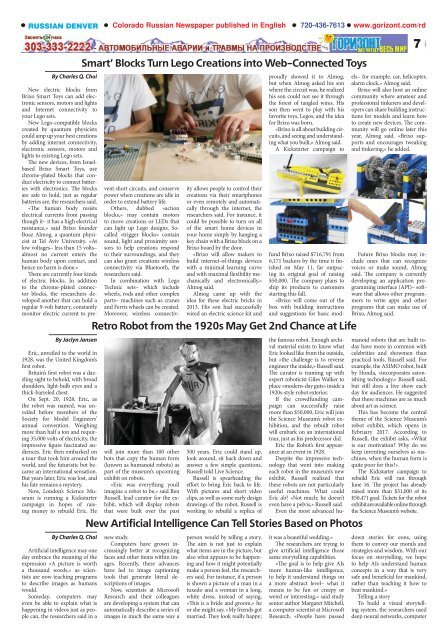Горизонт N22/851
Горизонт (газета) — (Gorizont англ. Horizon ) первая и наиболее влиятельная газета, издающаяся на русском языке в штатеКолорадо, США. Еженедельник, выходит по пятницам, формат Таблоид, 128 цветных и чернобелых страниц, распространяется в городах, составляющих метрополию Денвера (Большой Денвер), и в других населенных пунктах штата Колорадо от графства Саммит до графства Эль—Пасо. Полная электронная версия газеты «Горизонт» доступна в сети Интернет. Подробнее http://en.wikipedia.org/wiki/Gorizont_(newspaper)
Горизонт (газета) — (Gorizont англ. Horizon ) первая и наиболее влиятельная газета, издающаяся на русском языке в штатеКолорадо, США. Еженедельник, выходит по пятницам, формат Таблоид, 128 цветных и чернобелых страниц, распространяется в городах, составляющих метрополию Денвера (Большой Денвер), и в других населенных пунктах штата Колорадо от графства Саммит до графства Эль—Пасо. Полная электронная версия газеты «Горизонт» доступна в сети Интернет. Подробнее http://en.wikipedia.org/wiki/Gorizont_(newspaper)
Create successful ePaper yourself
Turn your PDF publications into a flip-book with our unique Google optimized e-Paper software.
Eric, unveiled to the world in<br />
y1928, was the United Kingdom’s<br />
first robot.<br />
Britain’s first robot was a dazzling<br />
sight to behold, with broad<br />
shoulders, light-bulb eyes and a<br />
thick-barreled chest.<br />
On Sept. 20, 1928, Eric, as<br />
the robot was named, was unveiled<br />
before members of the<br />
Society for Model Engineers’<br />
annual convention. Weighing<br />
more than half a ton and requiring<br />
35,000 volts of electricity, the<br />
impressive figure fascinated audiences.<br />
Eric then embarked on<br />
a tour that took him around the<br />
fworld, and the futuristic bot became<br />
an international sensation.<br />
But years later, Eric was lost, and<br />
his fate remains a mystery.<br />
Now, London’s Science Museum<br />
is running a Kickstarter<br />
campaign in hopes of raising<br />
money to rebuild Eric. He<br />
w<br />
RUSSIAN DENVER<br />
By Charles Q. Choi<br />
By Jaclyn Jansen<br />
By Charles Q. Choi<br />
Artificial intelligence may one<br />
day embrace the meaning of the<br />
expression «A picture is worth<br />
a thousand words,» as scientists<br />
are now teaching programs<br />
to describe images as humans<br />
would.<br />
Someday, computers may<br />
even be able to explain what is<br />
happening in videos just as people<br />
can, the researchers said in a<br />
Colorado Russian Newspaper published in English 720-436-7613 www.gorizont.com/rd<br />
Smart’ Blocks Turn Lego Creations into Web-Connected Toys<br />
New electric blocks from<br />
Brixo Smart Toys can add elec-<br />
sensors, motors and lights<br />
wtronic<br />
yand Internet connectivity to<br />
your Lego sets.<br />
New Lego-compatible blocks<br />
created by quantum physicists<br />
could amp up your best creations<br />
by adding internet connectivity,<br />
yelectronic sensors, motors and<br />
lights to existing Lego sets.<br />
The new devices, from Israelbased<br />
Brixo Smart Toys, use<br />
chrome-plated blocks that conduct<br />
electricity to connect batteries<br />
with electronics. The blocks<br />
yare safe to hold, just as regular<br />
batteries are, the researchers said.<br />
«The human body resists<br />
electrical currents from passing<br />
though it– it has a high electrical<br />
resistance,» said Brixo founder<br />
Boaz Almog, a quantum physi-<br />
at Tel Aviv University. «At<br />
ycist<br />
low voltages– less than 15 volts–<br />
yalmost no current enters the<br />
human body upon contact, and<br />
hence no harm is done.»<br />
There are currently four kinds<br />
of electric blocks. In addition<br />
to the chrome-plated connector<br />
blocks, the researchers developed<br />
another that can hold a<br />
regular 9-volt battery, constantly<br />
monitor electric current to prevent<br />
short circuits, and conserve<br />
power when creations are idle in<br />
order to extend battery life.<br />
Others, dubbed «action<br />
blocks,» may contain motors<br />
to move creations or LEDs that<br />
can light up Lego designs. Socalled<br />
«trigger blocks» contain<br />
sound, light and proximity sensors<br />
to help creations respond<br />
to their surroundings, and they<br />
can also grant creations wireless<br />
connectivity via Bluetooth, the<br />
researchers said.<br />
In combination with Lego<br />
Technic sets– which include<br />
wheels, rods and other complex<br />
parts– machines such as cranes<br />
and Ferris wheels can be created.<br />
Moreover, wireless connectivity<br />
allows people to control their<br />
creations via their smartphones<br />
or even remotely and automatically<br />
through the internet, the<br />
researchers said. For instance, it<br />
could be possible to turn on all<br />
of the smart home devices in<br />
your home simply by hanging a<br />
key chain with a Brixo block on a<br />
Brixo board by the door.<br />
«Brixo will allow makers to<br />
build internet-of-things devices<br />
with a minimal learning curve<br />
and with maximal flexibility mechanically<br />
and electronically,»<br />
Almog said.<br />
Almog came up with the<br />
idea for these electric bricks in<br />
2013. His son had successfully<br />
wired an electric science kit and<br />
proudly showed it to Almog,<br />
but when Almog asked his son<br />
where the circuit was, he realized<br />
his son could not see it through<br />
the forest of tangled wires. His<br />
son then went to play with his<br />
favorite toys, Legos, and the idea<br />
for Brixo was born.<br />
«Brixo is all about building circuits,<br />
and seeing and understanding<br />
what you built,» Almog said.<br />
A Kickstarter campaign to<br />
Retro Robot from the 1920s May Get 2nd Chance at Life<br />
will join more than 100 other<br />
bots that copy the human form<br />
(known as humanoid robots) as<br />
part of the museum’s upcoming<br />
exhibit on robots.<br />
«Eric was everything you’d<br />
imagine a robot to be,» said Ben<br />
Russell, lead curator for the exhibit,<br />
which will display robots<br />
that were built over the past<br />
500 years. Eric could stand up,<br />
look around, sit back down and<br />
answer a few simple questions,<br />
Russell told Live Science.<br />
Russell is spearheading the<br />
effort to bring Eric back to life.<br />
With pictures and short video<br />
clips, as well as some early design<br />
drawings of the robot, Russell is<br />
working to rebuild a replica of<br />
New Artificial Intelligence Can Tell Stories Based on Photos<br />
new study.<br />
Computers have grown increasingly<br />
better at recognizing<br />
faces and other items within images.<br />
Recently, these advances<br />
have led to image captioning<br />
tools that generate literal descriptions<br />
of images.<br />
Now, scientists at Microsoft<br />
Research and their colleagues<br />
are developing a system that can<br />
automatically describe a series of<br />
images in much the same way a<br />
person would by telling a story.<br />
The aim is not just to explain<br />
what items are in the picture, but<br />
also what appears to be happening<br />
and how it might potentially<br />
make a person feel, the researchers<br />
said. For instance, if a person<br />
is shown a picture of a man in a<br />
tuxedo and a woman in a long,<br />
white dress, instead of saying,<br />
«This is a bride and groom,» he<br />
or she might say, «My friends got<br />
married. They look really happy;<br />
it was a beautiful wedding.»<br />
The researchers are trying to<br />
give artificial intelligence those<br />
same storytelling capabilities.<br />
«The goal is to help give AIs<br />
more human-like intelligence,<br />
to help it understand things on<br />
a more abstract level– what it<br />
means to be fun or creepy or<br />
weird or interesting,» said study<br />
senior author Margaret Mitchell,<br />
a computer scientist at Microsoft<br />
Research. «People have passed<br />
7<br />
fund Brixo raised $716,791 from<br />
6,171 backers by the time it finished<br />
on May 11, far outpacing<br />
its original goal of raising<br />
$50,000. The company plans to<br />
ship its products to customers<br />
starting this fall.<br />
«Brixo will come out of the<br />
box with building instructions<br />
and suggestions for basic models–<br />
for example, car, helicopter,<br />
alarm clock,» Almog said.<br />
Brixo will also host an online<br />
community where amateur and<br />
professional tinkerers and developers<br />
can share building instructions<br />
for models and learn how<br />
to create new devices. The community<br />
will go online later this<br />
year, Almog said. «Brixo supports<br />
and encourages tweaking<br />
and tinkering,» he added.<br />
Future Brixo blocks may include<br />
ones that can recognize<br />
voices or make sound, Almog<br />
said. The company is currently<br />
developing an application programming<br />
interface (API)– software<br />
that allows other programmers<br />
to write apps and other<br />
programs that can make use of<br />
Brixo, Almog said.<br />
the famous robot. Enough archival<br />
material exists to know what<br />
Eric looked like from the outside,<br />
but «the challenge is to reverse<br />
engineer the inside,» Russell said.<br />
The curator is teaming up with<br />
expert roboticist Giles Walker to<br />
place «modern-day guts» inside a<br />
1920s-style robot exterior.<br />
If the crowdfunding campaign<br />
can successfully raise<br />
more than $50,000, Eric will join<br />
the Science Museum’s robot exhibition,<br />
and the rebuilt robot<br />
will embark on an international<br />
tour, just as his predecessor did.<br />
Eric the Robot’s first appearance<br />
at an event in 1928.<br />
Despite the impressive technology<br />
that went into making<br />
each robot in the museum’s new<br />
exhibit, Russell realized that<br />
these robots are not particularly<br />
useful machines. What could<br />
Eric do? «Not much; he doesn’t<br />
even have a pelvis,» Russell said.<br />
Even the most advanced humanoid<br />
robots that are built today<br />
have more in common with<br />
celebrities and showmen than<br />
practical tools, Russell said. For<br />
example, the ASIMO robot, built<br />
by Honda, «incorporates astonishing<br />
technology,» Russell said,<br />
but still does a live show each<br />
day for audiences. He suggested<br />
that these machines are as much<br />
about art as science.<br />
This has become the central<br />
theme of the Science Museum’s<br />
robot exhibit, which opens in<br />
February 2017. According to<br />
Russell, the exhibit asks, «What<br />
is our motivation? Why do we<br />
keep inventing ourselves as machines,<br />
when the human form is<br />
quite poor for this?»<br />
The Kickstarter campaign to<br />
rebuild Eric will run through<br />
June 16. The project has already<br />
raised more than $31,000 of its<br />
$50,471 goal. Tickets for the robot<br />
exhibit are available online through<br />
the Science Museum’s website.<br />
down stories for eons, using<br />
them to convey our morals and<br />
strategies and wisdom. With our<br />
focus on storytelling, we hope<br />
to help AIs understand human<br />
concepts in a way that is very<br />
safe and beneficial for mankind,<br />
rather than teaching it how to<br />
beat mankind.»<br />
Telling a story<br />
To build a visual storytelling<br />
system, the researchers used<br />
deep neural networks, computer
















